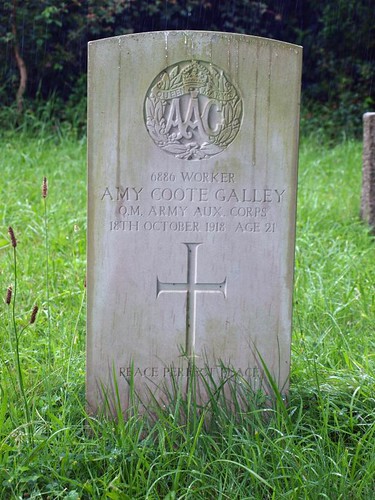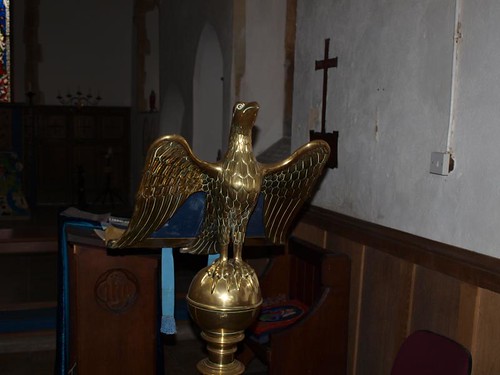ST MARY. Nave and chancel without division; W tower. The lower parts of the tower are Norman, the diagonal buttresses and the broach-spire C15 or later. The rest of the church is C14, except for one Early Tudor brick window in the S side and the absolutely plain brick S porch. The only things calling for attention are the Sedilia, two seats with cusped pointed arches on detached shafts, and the nave roof with tie-beams on shallow arched braces, and queen-posts. - STAINED GLASS. E window, 1860, looks as if it might be Hardmans. - BRASS to William Fyscher and wife, c. 1530, with children; small figures, the parents only c. 10 ins.
GREAT HENNY. Much of its tower is Norman, and one of the bells has been ringing 500 years. The church was refashioned in the 14th century, and given a new brick porch 200 years later. In the opposite doorway a 15th century door is still opening and closing.There is a sanctuary chair 300 years old, finely carved, and a table in the vestry as old. A chest thought to have come from Italy in the 16th century is now the altar of the children’s chapel; and on the chancel wall are brass portraits of William Fyscher, his wife Anne, and their 15 children, all in the costume of Henry the Eighth’s day. With windows jutting from its thatched roof is the quaint village hall, a pair of cottages transformed for this good purpose by the men of the parish themselves. One who must have loved all these things in the 18th century was Jacob Brome, rector for 57 years.
Simon K -
This is hilly country, and Great Henny church crowns the highest of
them, above the village and away from the houses as if it were a
castle. The rain began again as I passed through Henny Street, and as
I turned into the wind a mile or so short of my destination it
worsened. As I reached the bottom of the track which leads up to the
top of the hill, I looked down at my waterproof top and saw white
flakes accumulating - snow! It didn't last however, and by the time I
reached the sanctuary of the top it had stopped. I parked my bike in
the porch of the church.
Open. It has a rather forbidding appearance, a long hall of a church and the tower surmounted by a tall 18th century spire, but I needn't have worried. This is a really friendly, welcoming church. It is part of the 'pilgrim places' network, a nationwide organisation of churches and other buildings which promise to welcome pilgrims and travellers. This church is always open, guarded by a row of cottages on the side of the churchyard.
Inside, all is 19th Century, though pleasantly so. As I started looking around the sun came out, so I went outside to do the exterior. The odd structure on the edge of the churchyard is a dummy spire designed to encourage woodpeckers to attack it and not the church spire!
A curiosity of this area is that all the churches are anglo-Catholic in character to some degree, and several have glass by the Birmingham-based Hardman workshop, who ordinarily supplied catholic churches and are relatively uncommon in Anglican churches. This seems too much of a coincidence not to be significant.
I liked this church a lot, despite the alarming marble font and not having terribly much of interest other than a few rescued brasses pinned to the wall.
As part of their 'pilgrim place' status, they sell packets of lupin and honesty to scatter as you go about your pilgrimage. Not sure what the Essex Trust for Nature Conservation would make of that, but I bought some anyway.
Simon K -
The early sun was shining in a clear blue sky when I left Ipswich, but
by the time I reached Sudbury there was, as predicted, a wintry
shower. I waited for the worst of it to pass, and then set off through
Ballingdon over the border into Essex and to Middleton (already
visited), climbing ever higher on narrower, windier and hillier lanes,
up through Henny Street and then on towards Great Henny.
Open. It has a rather forbidding appearance, a long hall of a church and the tower surmounted by a tall 18th century spire, but I needn't have worried. This is a really friendly, welcoming church. It is part of the 'pilgrim places' network, a nationwide organisation of churches and other buildings which promise to welcome pilgrims and travellers. This church is always open, guarded by a row of cottages on the side of the churchyard.
Inside, all is 19th Century, though pleasantly so. As I started looking around the sun came out, so I went outside to do the exterior. The odd structure on the edge of the churchyard is a dummy spire designed to encourage woodpeckers to attack it and not the church spire!
A curiosity of this area is that all the churches are anglo-Catholic in character to some degree, and several have glass by the Birmingham-based Hardman workshop, who ordinarily supplied catholic churches and are relatively uncommon in Anglican churches. This seems too much of a coincidence not to be significant.
I liked this church a lot, despite the alarming marble font and not having terribly much of interest other than a few rescued brasses pinned to the wall.
As part of their 'pilgrim place' status, they sell packets of lupin and honesty to scatter as you go about your pilgrimage. Not sure what the Essex Trust for Nature Conservation would make of that, but I bought some anyway.



No comments:
Post a Comment